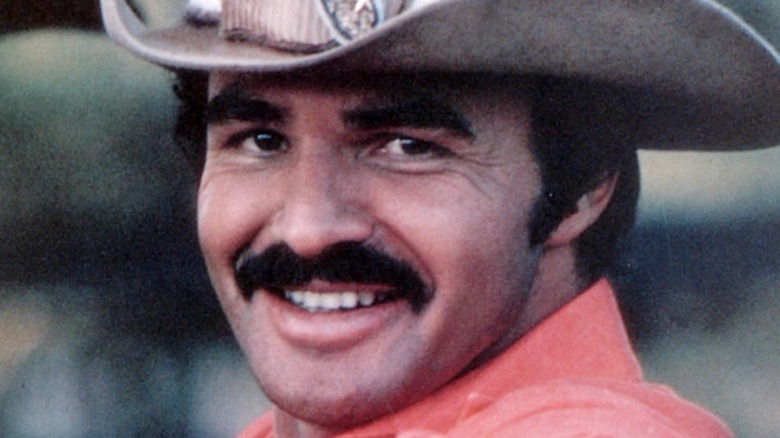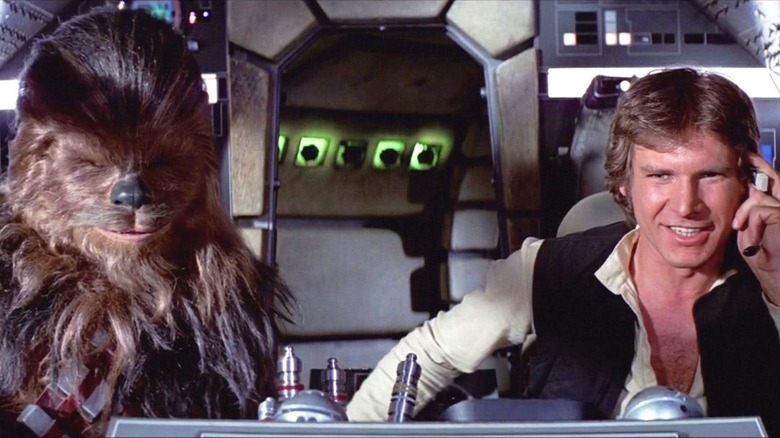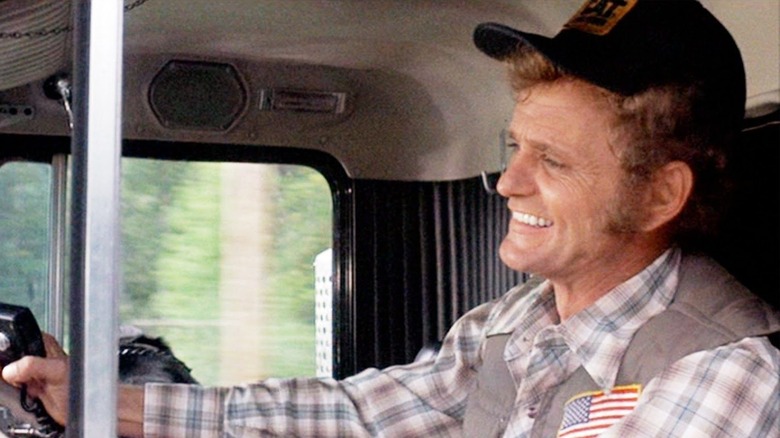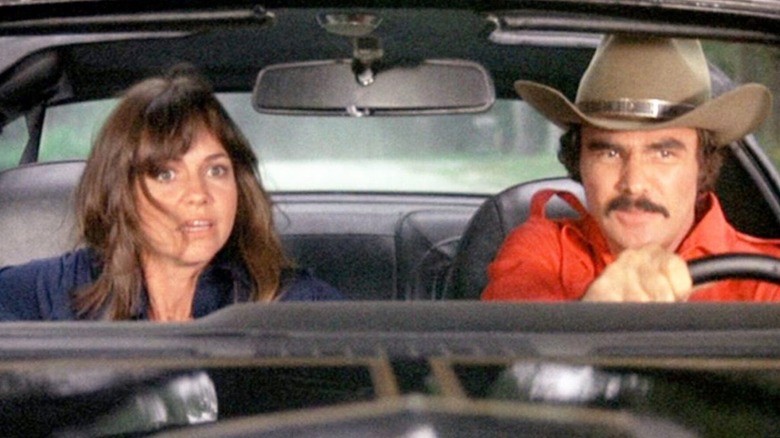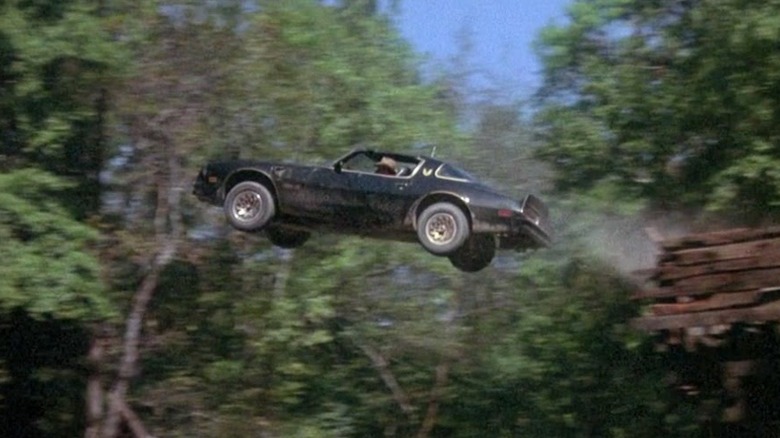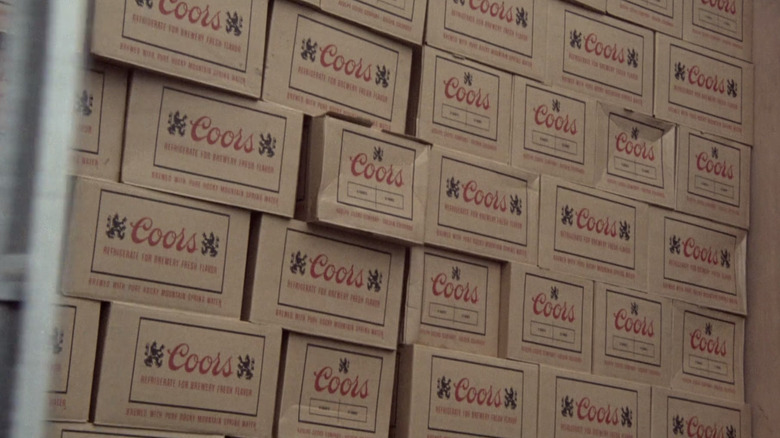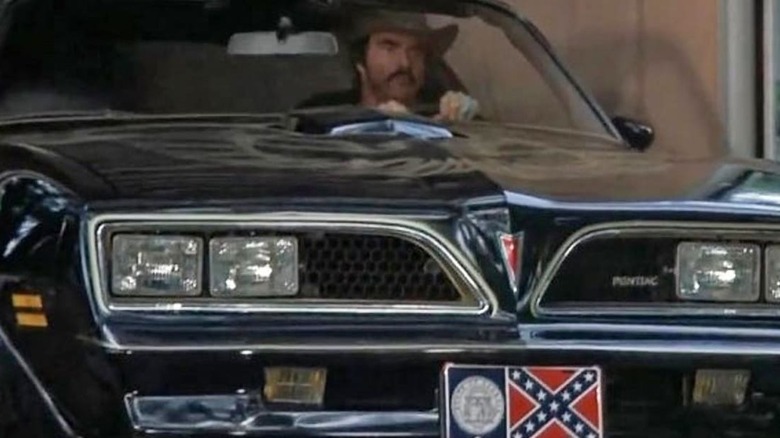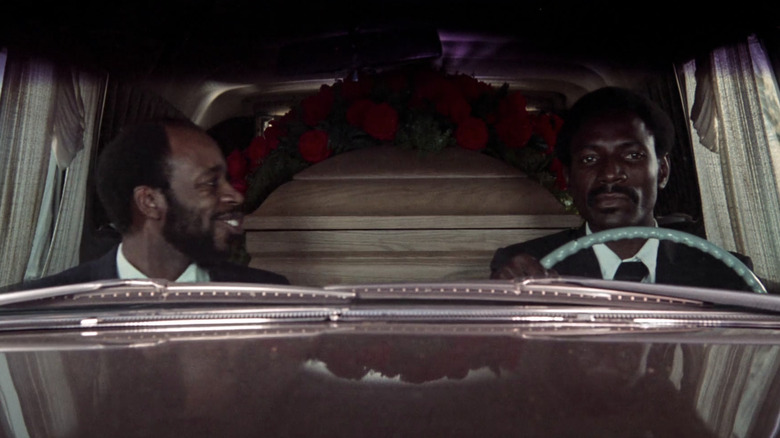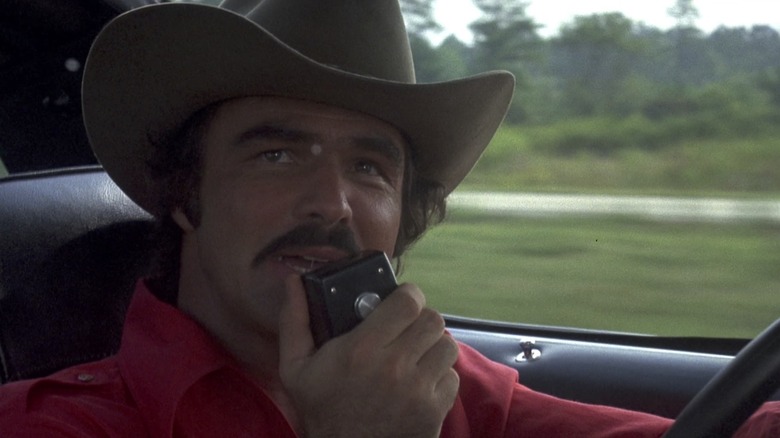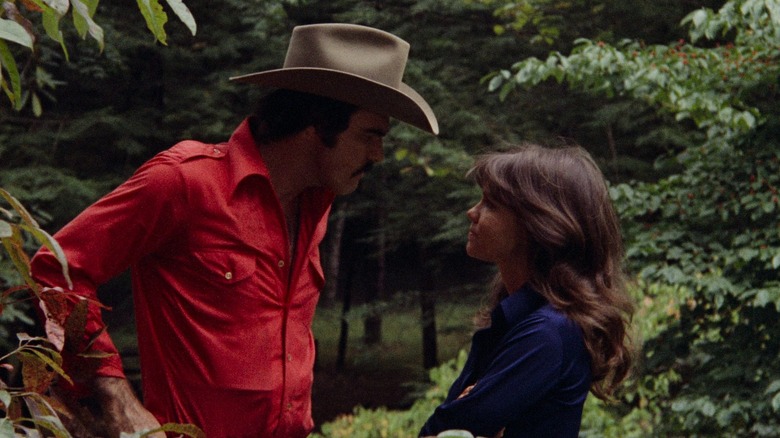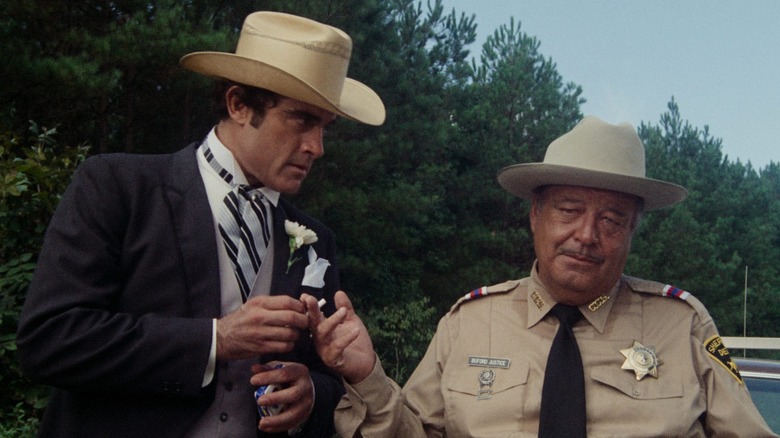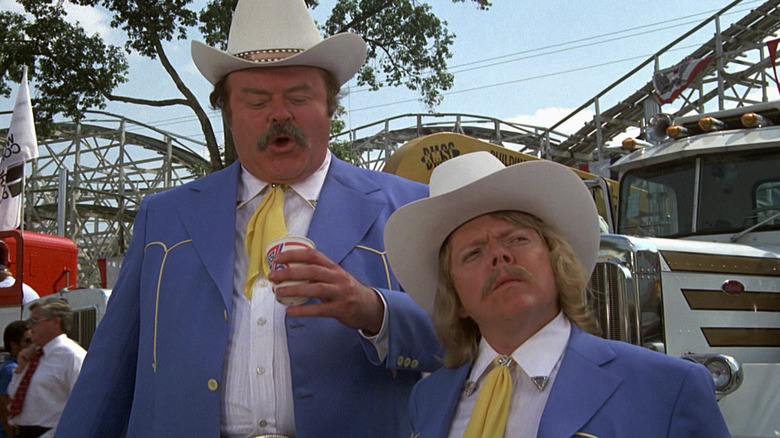Things You Forgot Happened In Smokey And The Bandit
1977 was a major turning point for Hollywood as we know it. The massive success of "Star Wars" changed the landscape forever and set a blueprint for big-budget franchises that endures nearly 50 years later.
But there was another action blockbuster that held its own against "Star Wars" at the box office. It may not be as universally remembered, but it's still just as much a classic in its own right. Like "Star Wars," "Smokey and the Bandit" put a layer of Hollywood gloss on a disreputable genre. But instead of science fiction, director Hal Needham set his sights on the quick-and-dirty regional thrillers that lit up small American theaters, and especially the subgenre of "trucksploitation" that grew out of the '70s' brief but intense CB radio craze.
"Smokey and the Bandit" took a story that would have fit right in at a rural grindhouse theater — of a trucker racing across the country with the law in hot pursuit — and dressed it up with the star power of "Deliverance" lead Burt Reynolds, "The Honeymooners" icon Jackie Gleason, and former "The Flying Nun" star Sally Field. Beyond that, Needham used all the resources of a major studio to create the world's greatest demolition derby, with stunts so spectacular you may need a second viewing to believe what you're seeing.
That's a lot to take in, but there's even more to "Smokey and the Bandit" that may have slipped your mind, especially if you haven't seen it since it first sold out theaters.
The Star Wars parallels
The box office rivalry between "Smokey and the Bandit" and "Star Wars" becomes almost eerie when you start to see how similar the two movies are. Bandit is transporting contraband in defiance of the law — in a word, he's a smuggler, and Burt Reynolds brings the same cocky charm to the character that Harrison Ford brought to Han Solo. Bandit's sidekick Snowman (Jerry Reed) even drives around with a big, slobbery basset hound in the passenger seat, looking for all the world like Chewie in the cockpit of the Millennium Falcon.
Sally Field gives Bandit's love interest Frog the same scrappy toughness Carrie Fisher brought to Princess Leia. You can even get the sense that the makers of "Star Wars" were copying notes from "Smokey" — when they began setting up a romance between Han and Leia in "The Empire Strikes Back," their flirt-fight-flirt dynamic could have come straight off the pages of the "Smokey" script.
But the differences are just as intriguing. The "Star Wars"' galaxy may have been scuzzier than the space epics of the past, but it still promised viewers a window into another world. "Smokey and the Bandit" filmed on location in even scuzzier spots, diving into the grit and grime of the real American South. Everything's covered in rust and red clay, and you can almost smell the cigarettes and sweat. That's not just atmosphere — in such a real world, you can almost believe in all the cartoon action onscreen.
Bandit's introduced truck-first
"Smokey and the Bandit" entered theaters at a strange time in Hollywood history. With a mass exodus of the theatergoing audience to TV, the sure things of the past were now anything but. The collapse of the movie industry's bread-and-butter musicals and historical epics with high-profile flops like "Hello, Dolly!" and "Cleopatra" left producers scrambling for anything that could keep them relevant. Add this chaos to the countercultural explosion of the '60s and '70s that produced some of Hollywood's biggest surprise hits, like "2001" and "Easy Rider," and suddenly the avant-garde was mainstream.
"Smokey and the Bandit" is about as meat-and-potatoes as action filmmaking gets, but you can still see the influence of this strange time in movie history in its opening. The straightforward chase scenes will have to wait: Instead, we get an almost collage-like series of shots of the truck Snowman will drive for the next hour-and-a-half, one piece at a time, so close up they'll look almost abstract to everyone but the gearheads in the crowd. It's hard to imagine any movie today throwing out traditional narrative before most of the audience have even had time to find their seats.
The dialogue's as fast-paced as the driving
"Smokey and the Bandit" delivers the lowbrow goods first and foremost, but the filmmaking experiments of the previous decade have still left their thumbprints all over it. One of the biggest shifts in the era was from polished, theatrical acting and scripting to the loose, improvisational style pioneered by directors like John Cassavettes and Robert Altman. '70s movies were often, to use a phrase from the era that's recently come back in vogue, "just vibes." What the characters did wasn't as important as what they said, and they said so much of it you might have a hard time keeping up, especially since the actors delivered their lines rapid-fire and offhand without the background noise letting up or the camera cutting to their faces to emphasize it.
Fitting for a movie based on the overheard chatter of CB radios, "Smokey and the Bandit" takes that approach and runs with it. The dialogue's every bit as fast-paced and witty as the classic comedies of the '30s and '40s, but there's a lot less hand-holding to make sure you catch it all. Reynolds and Fields deliver it less like they know an audience is watching and more like real people muttering under their breath. But it's worth the effort to listen in.
Bandit isn't actually a trucker
"Smokey and the Bandit" is the most enduring example of the brief but wildly popular trucksploitation genre, and it reached that height even though — or maybe because — it has very little trucking in it.
Hal Needham seems to have realized it's hard to make a big, slow, clumsy 18-wheeler exciting, so he leaves all the actual trucking to Snowman and puts Bandit behind the wheel of a sleek, sexy Trans Am. The script justifies this by explaining that Bandit's a "blocker" — his job is to drive flashily and recklessly to distract the cops while Snowman does his work and warn the latter when they're on his trail. Mind you, we haven't been able to find any evidence this practice exists outside this movie. But if it is pure invention, it paid off — it's hard to imagine anyone pulling off any of the spectacular car jumps and swerves in a truck the size of a house.
The reason shipping Coors is such a big deal
Maybe the strangest thing about watching "Smokey and the Bandit" so many years on is the catalyst for the whole plot. Two businessmen, Big and Little Enos, make a bet with Bandit to smuggle a truckload of Coors from Texarkana, Texas to Atlanta, Georgia. The characters all insist this is a dangerous, illegal mission — "bootlegging," in their words. Now that you can buy Coors at any gas station in Atlanta — or as far away as Paris if you want it — you may need some reminding just what the big deal was.
The New York Times reports that back in 1977, getting Coors east of the Mississippi really was that big a deal. At the time, Coors was a relatively small operation, only available in 11 western states. And good luck getting it anywhere else — believing pasteurization would destroy their unique flavor, the makers of Coors could only transport their wares short distances without spoiling it.
Management was deliberate in keeping the operation small — the rarity gave their beer an almost mythical mystique in the East, where a case could retail for as much as $15.00 (almost $30 in today's money). But that strategy could only hold out so long, and as Coors became a national brand, Bandit's daring mission started to seem like just another job.
Bandit's questionable Confederate customization
"Smokey and the Bandit" is rooted deep in the rebellious spirit of the '70s. Bandit is just what his name says — an outlaw, living by his own rules and making fools of everyone enforcing the rules of broader American society (not that Sheriff Buford T. Justice needs much help).
That spirit of the '70s is still alive and well in the '20s. But after decades of seeing the forces of the status quo co-opt the imagery of rebellion to make society even more oppressive, viewers today are likely to be much more concerned about just what their heroes are rebelling against. So it's more than a little ironic that Bandit expresses his commitment to the countercultural ideals that produced the Black Power movement with a license plate bearing the Georgia flag, which until 2001(!) proudly bore the stars 'n' bars of the Confederacy — not exactly a group known for their allegiance to Black Power.
In 1977, the Rebel flag could still plausibly serve as a neutral-to-positive symbol for rebellion. But it's become harder to ignore in the decades since that the Civil War wasn't just about the noble pursuit of freedom but the specific freedom to deprive others of their freedom. It gets even more confusing since Snowman has a Union flag stitched onto his vest — whose side is this duo really on?
Bandit brings the races together
Despite Bandit's vanity-plate faux pas, "Smokey" is very much a reflection of the '70s dream of a refuge outside mainstream society where people of all races could come together. The movie wouldn't exist without the CB (citizen's band) radio craze. People from all walks of life discovered the radio frequencies truckers used to communicate among themselves and began conversations that could stretch all across the country.
That's a major plot point in "Smokey and the Bandit," which takes its name from CB slang — "Smokey" being code for the police, or more broadly, The Man. A whole ensemble of CB listeners appear throughout the movie to help Bandit get his cargo to Atlanta, and it's a pretty diverse bunch — men and women, young and old, Black, white, and Asian.
The subtext should be clear: Bandit's struggle with the law has resonated with all these other people and their own conflicts with authority, uniting them across all demographic boundaries. There's few better images of The Man than Gleason's Sheriff Buford T. Justice, loud, aggrieved, self-important, proudly racist, and deeply convinced of his own nonexistent prowess in all fields. Needham's vision of racial togetherness doesn't quite extend far enough to avoid giving the Asian trucker some embarrassingly stereotypical dialogue. But as the Fresh Prince might say, he got the spirit.
Bandit's already a legend in his first appearance
"Smokey and the Bandit" arrived at the beginning of the modern franchise era, and even though the movie itself earned two sequels, the rules of franchise filmmaking weren't yet set in stone. In 1977, sequels were generally an afterthought — you only had one movie to establish your characters and their world, and any time setting the table was time wasted.
So it can be odd to put on "Smokey and the Bandit" and feel like you're watching the third or fourth entry in a modern movie series. Most current franchises begin at the beginning, showing how their heroes began their careers. But by the time we meet Bandit, his career's already pretty much over.
Sometime before the events of the movie, he's become such a legend in the trucking world that he takes up more of his time appearing at county fairs to adoring fans than actually hauling cargo. In fact, he seems to be more or less retired before Big and Little Enos's promise of an astronomical payout gets him back on the road. As for Snowman, he needs even more convincing. We know the two of them are close friends, but they apparently haven't worked together in years.
Bandit's trip isn't as impressive as it sounds
"We're gonna do what they say can't be done," says the "Smokey and the Bandit" theme song, sung by Snowman himself, Jerry Reed. "We've got a long way to go, and a short time to get there/I'm eastbound, just watch ol' Bandit run." As it turns out, though, the road from Atlanta to Texarkana isn't such a long way to go, and 28 hours isn't such a short time to get there at all. A quick Google search reveals the round trip is just over 1,000 miles. Even if you were to obey all the speed limits — something Bandit's obviously not too concerned about — you can still make the round trip with almost 10 hours to spare.
Of course, that's taking the interstate, and most of "Smokey and the Bandit" takes place on narrow backroads. That would take quite a bit longer, and maybe Bandit wanted to stay off the main roads to avoid the smokies. Then again, the whole movie proves that was a pretty doomed effort. It seems more likely Needham just wanted to get those locations for the atmosphere of the heavily wooded two-lane blacktop. As for the timing, maybe he just couldn't be bothered to pull out a map to confirm Bandit's impossible task was as impossible as advertised.
The MPAA said Smokey was fun for the whole family
Especially compared to the heroes of most big-budget movies made in the decades before and after, the cast of "Smokey and the Bandit" have vocabularies that sound more like sailors than truckers. So it can be surprising how inconsistent the movie's profanity is. For instance, Bandit sends Buford the message "F.O." without filling in the letters in between; when Buford tells a fellow officer to do the same, he gets drowned out by a truck horn. Surely, if the filmmakers are willing to include as much salty language (and sexual content, vehicular violence, and other adults-only content) as they already have, what's the sense in saying "when?"
The MPAA turns out to be the reason. "Smokey and the Bandit" may be a long way from the frolicking cartoon critters we associate with the PG rating today, but that's exactly what it got. When "Smokey" premiered in the early days of the rating system, PG films were aimed at a much more general audience than they are today, with G being the standard rating for family flicks. But outrage over the family-unfriendly violence of the PG-rated "Gremlins" and "Indiana Jones and the Temple of Doom" led to the new PG-13 rating. Whatever effort went into that turned out to be wasted. Over the following decades, PG-13 slowly slid into the niche of the old PG rating, PG displaced G almost entirely, and we ended up right back where we started.
That's the Muppets' songwriter as Little Enos
Between Field, Reynolds, and Gleason, "Smokey and the Bandit" had enough big stars to guarantee butts in seats. But it featured some smaller stars too, and we're not just talking in terms of reputation. The 5' 2" singer-songwriter Paul Williams appears as Little Enos.
Williams had a long and profitable career in the music business, writing hits for acts as varied as David Bowie, Helen Reddy, and the Carpenters, who took him to Number Two with their take on "Rainy Days and Mondays." But Williams had some of his most lasting success in the movies, writing songs for "The Secret of NIMH," "Bugsy Malone," the Barbra Streisand/Kris Kristofferson remake of "A Star Is Born," and the cult classic "Phantom of the Paradise," where he also starred as a Satanic record producer. But even if you've never heard any of these songs, it's hard to imagine you've escaped his classic score for "The Muppet Movie," including the iconic, Oscar-nominated heart-tugger "The Rainbow Connection." He'd return to the Muppet crew for "A Muppet Christmas Carol" and "Emmett Otter's Jug Band Christmas." Maybe, like he said when he guest starred on "The Muppet Show," he just liked being the tallest guy around for once.
